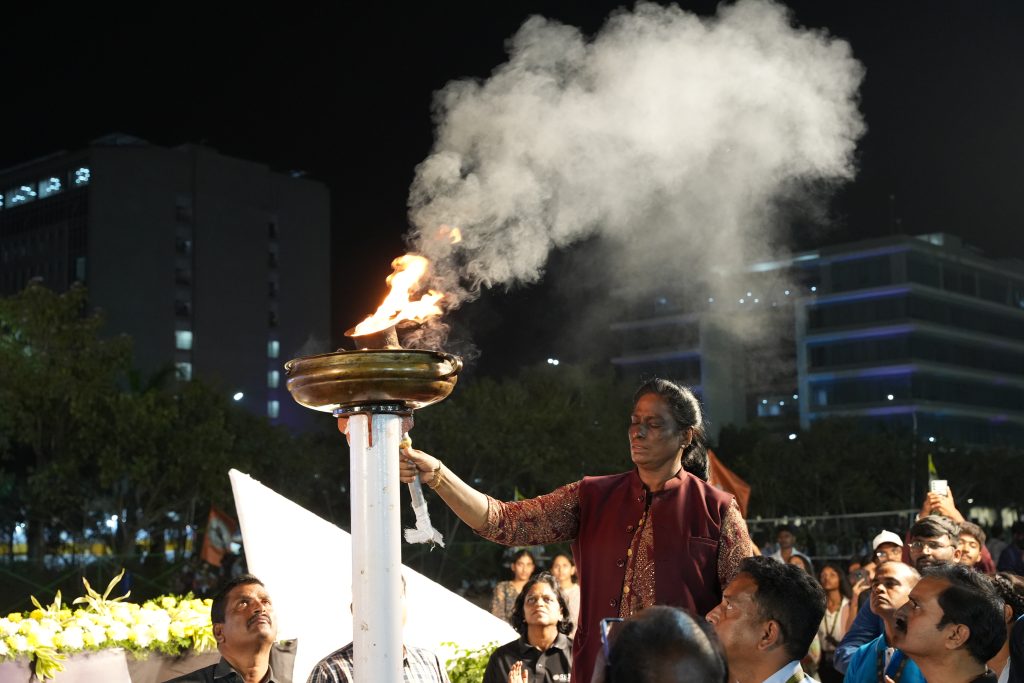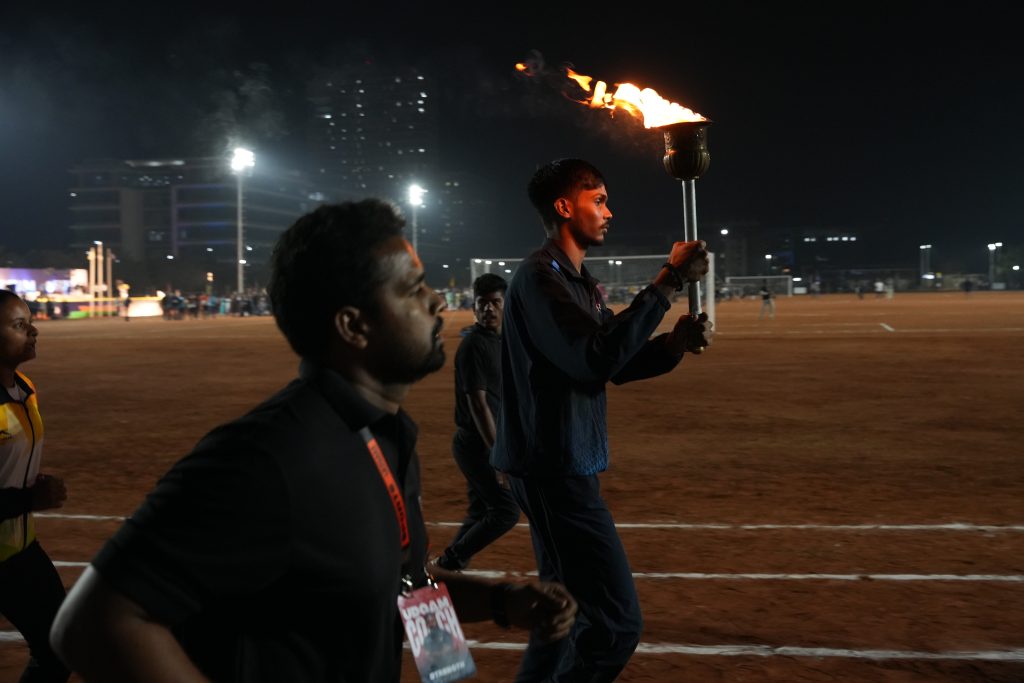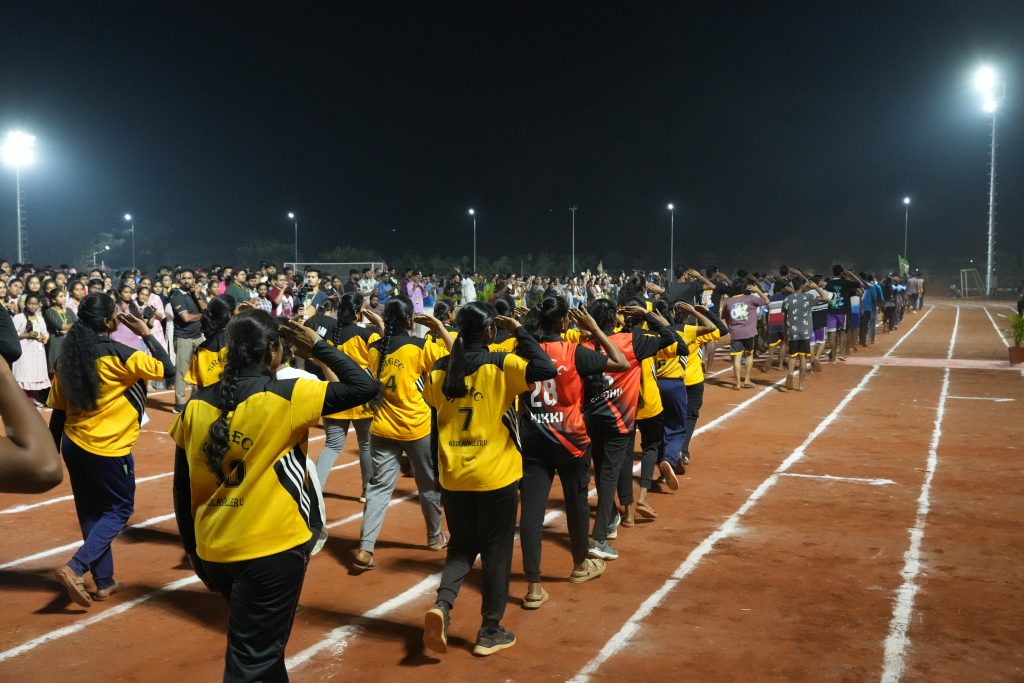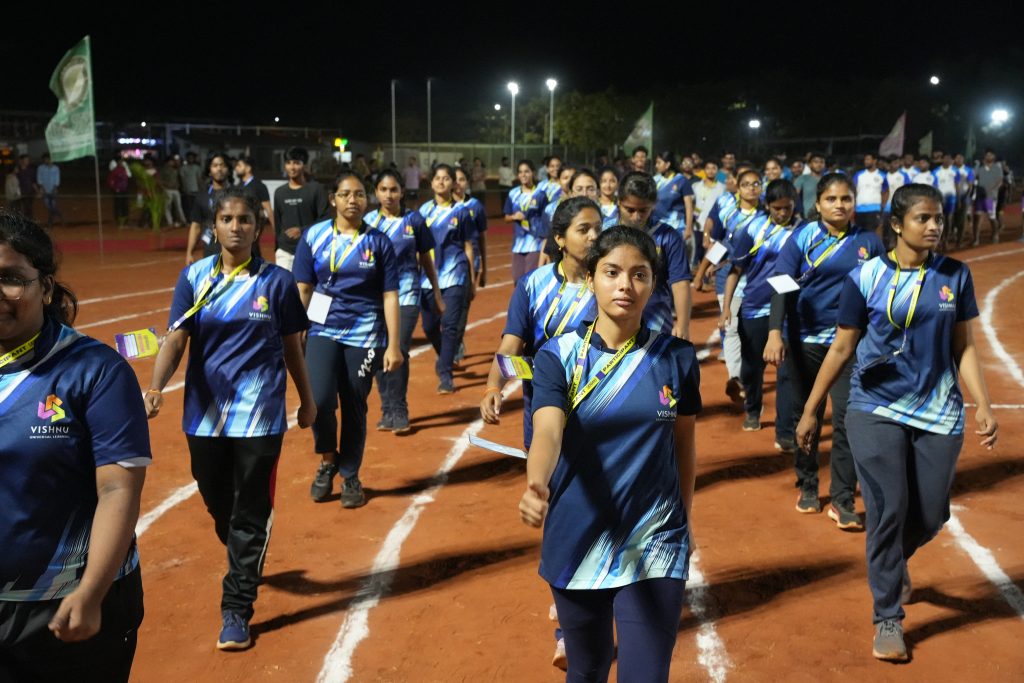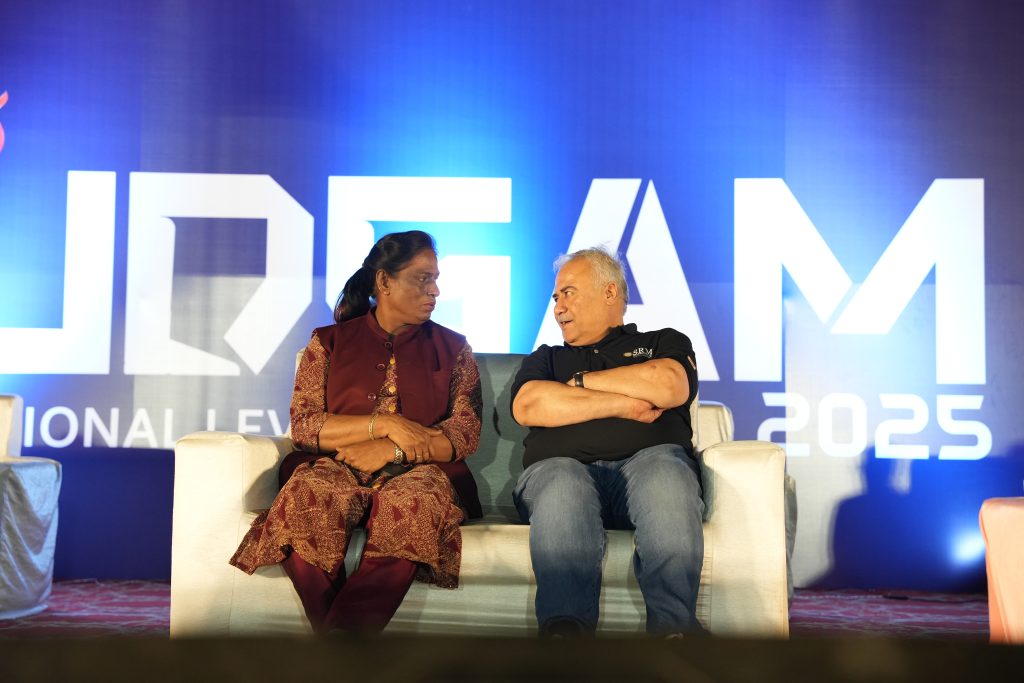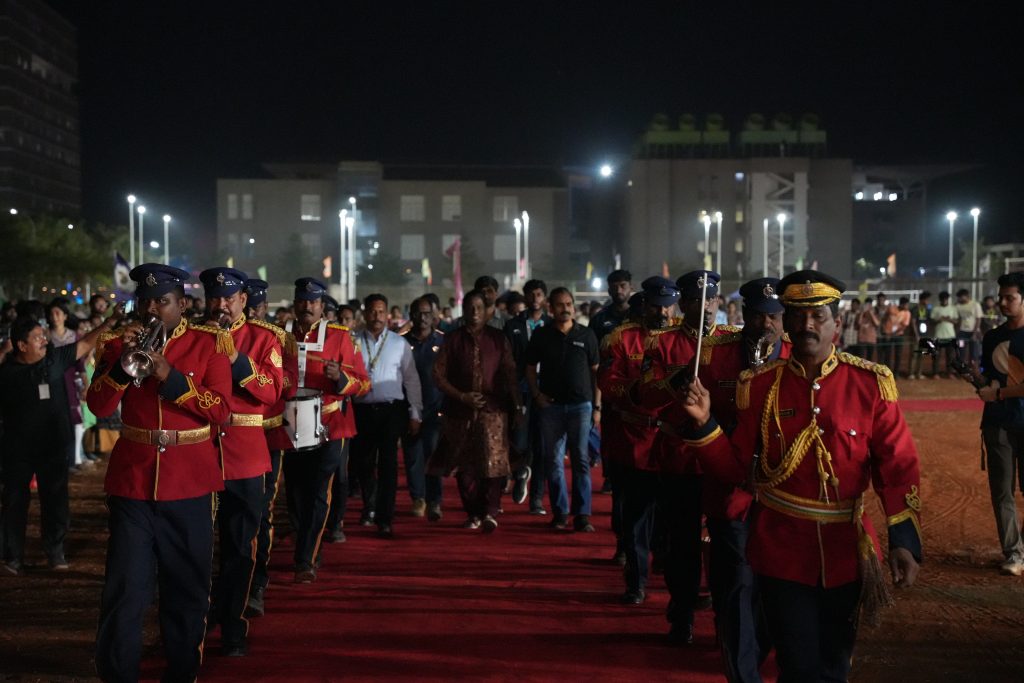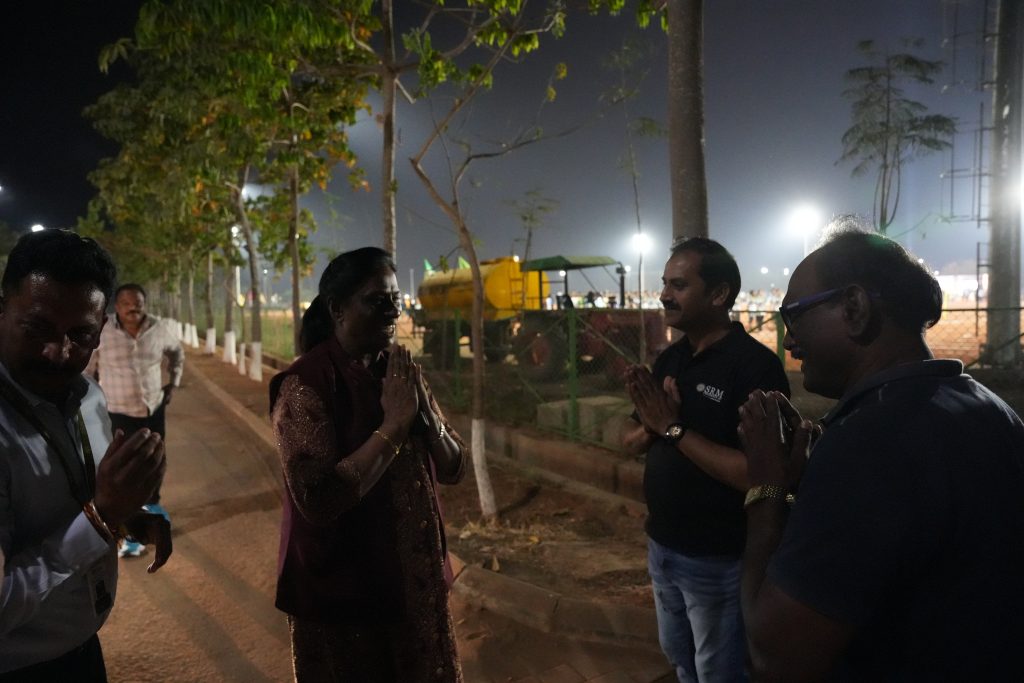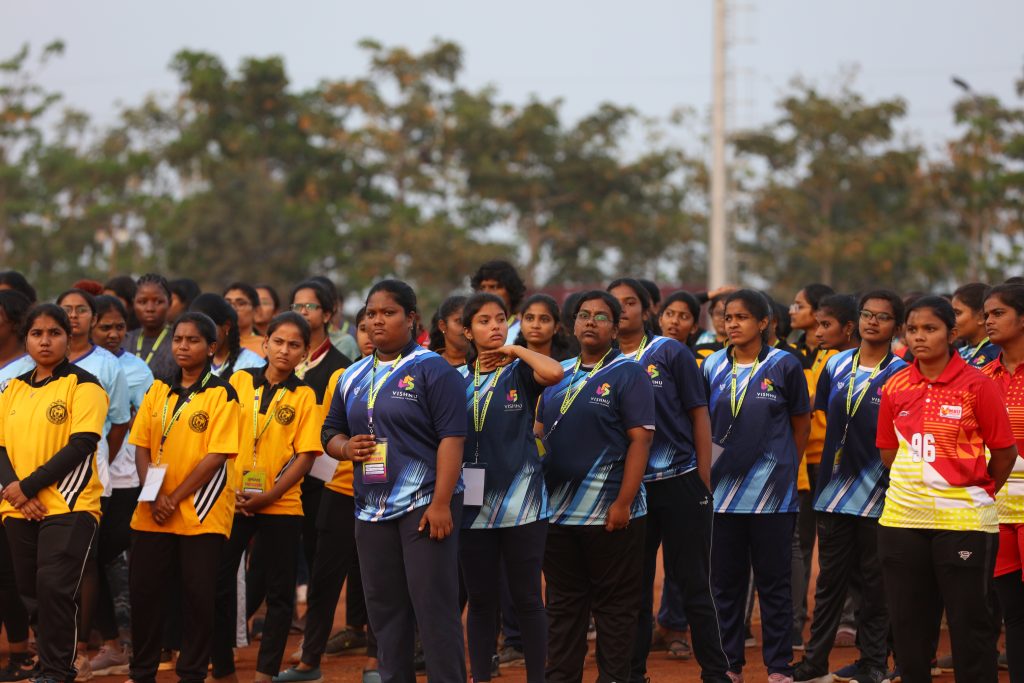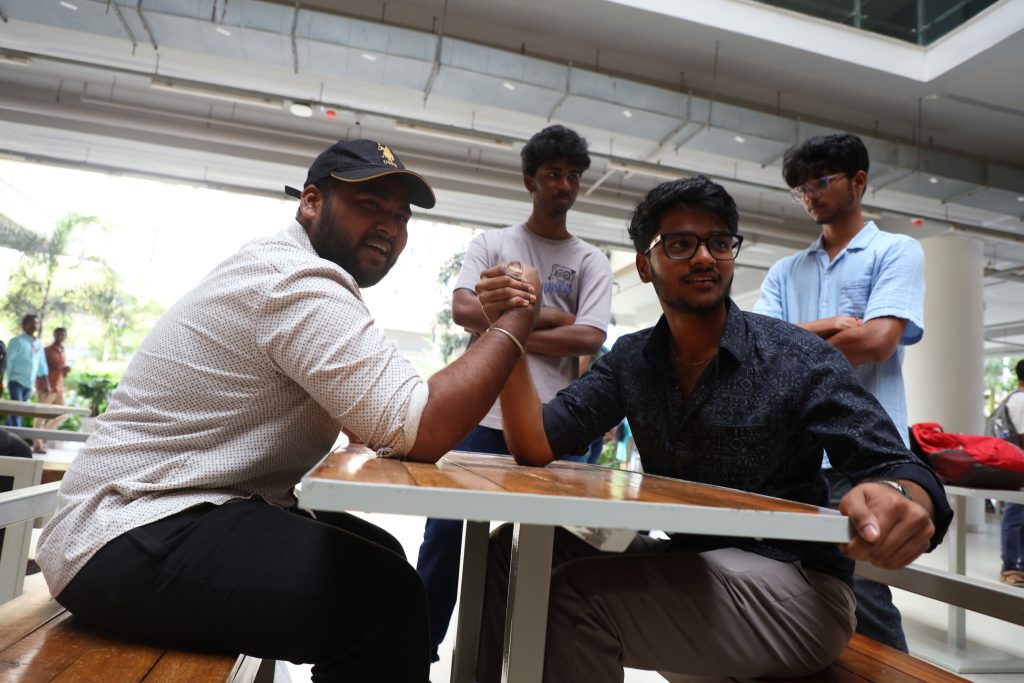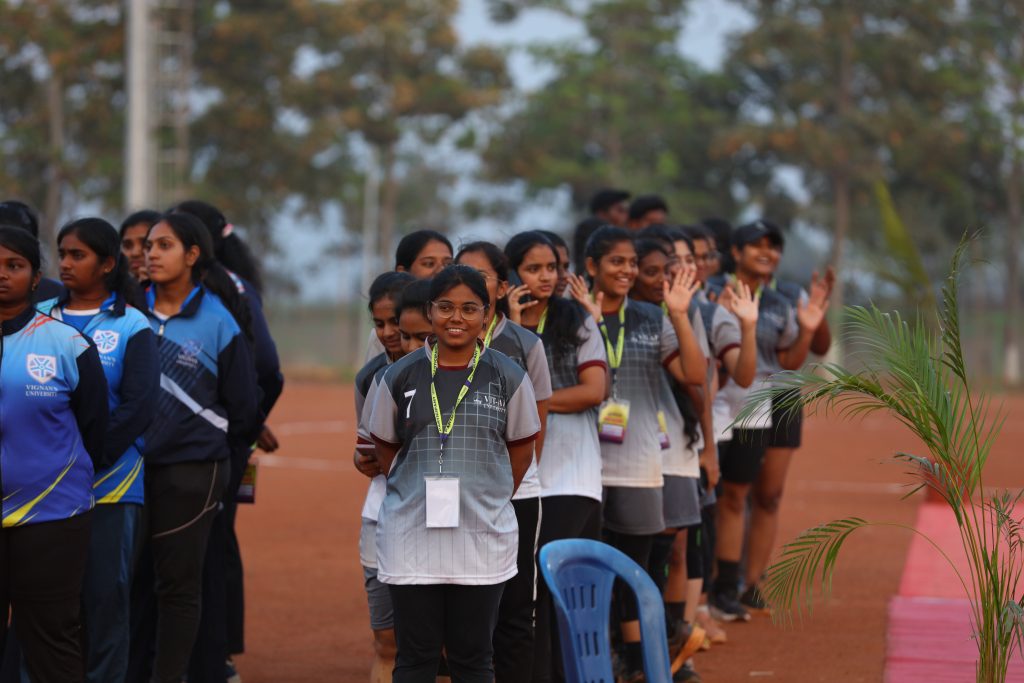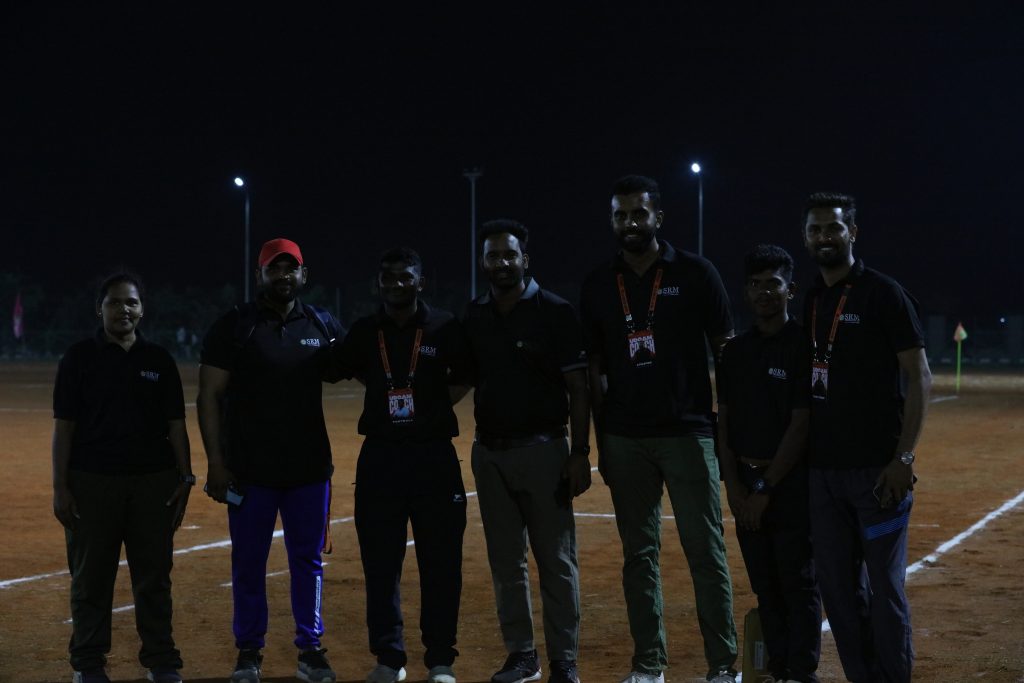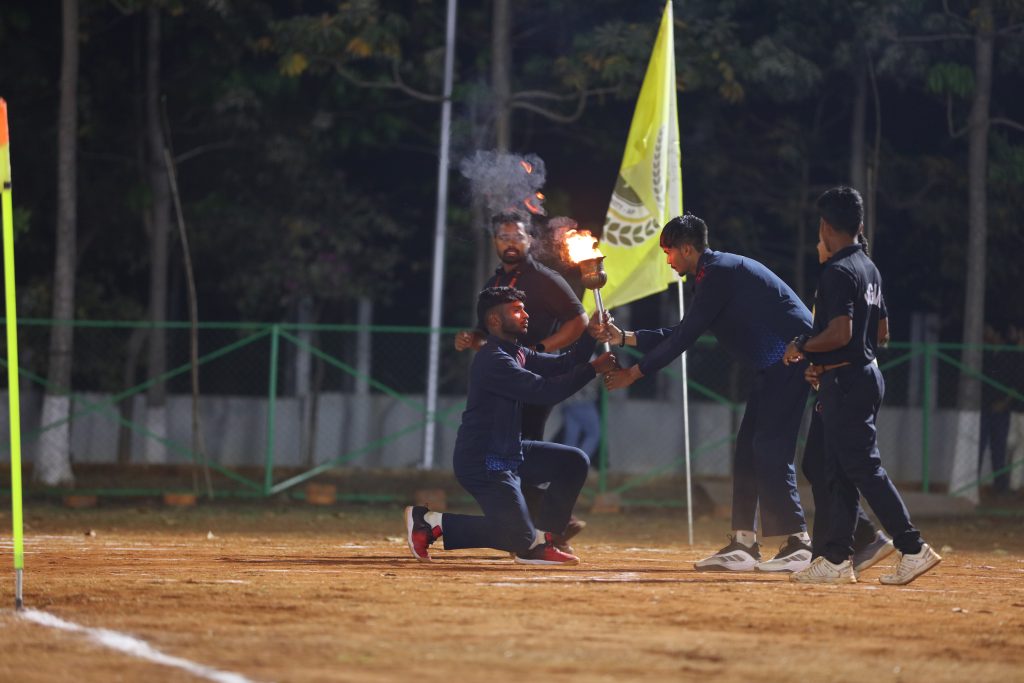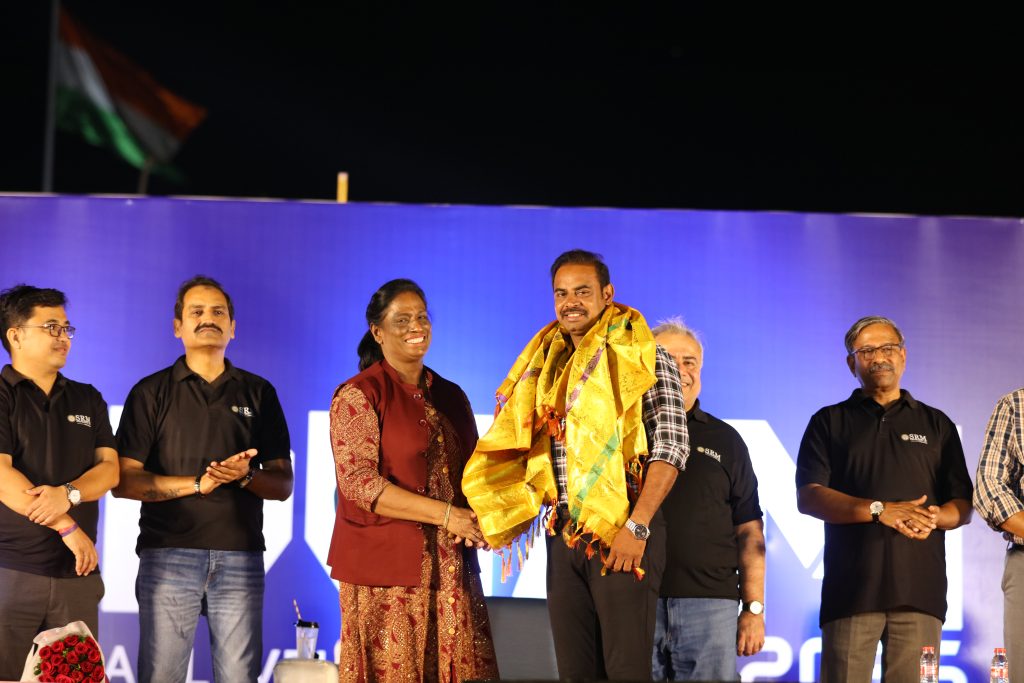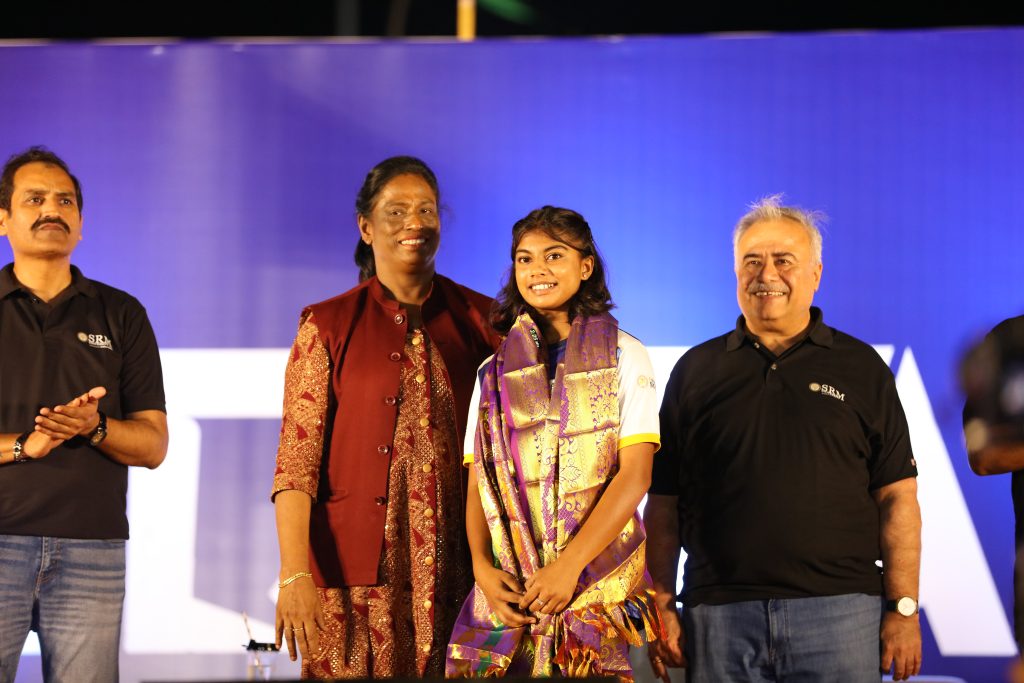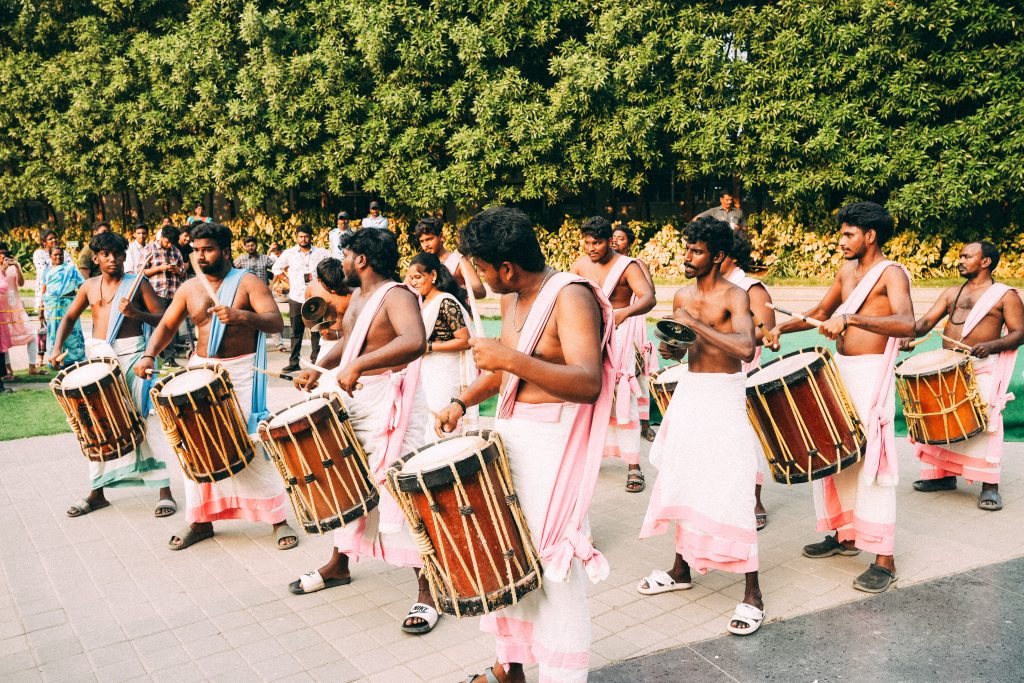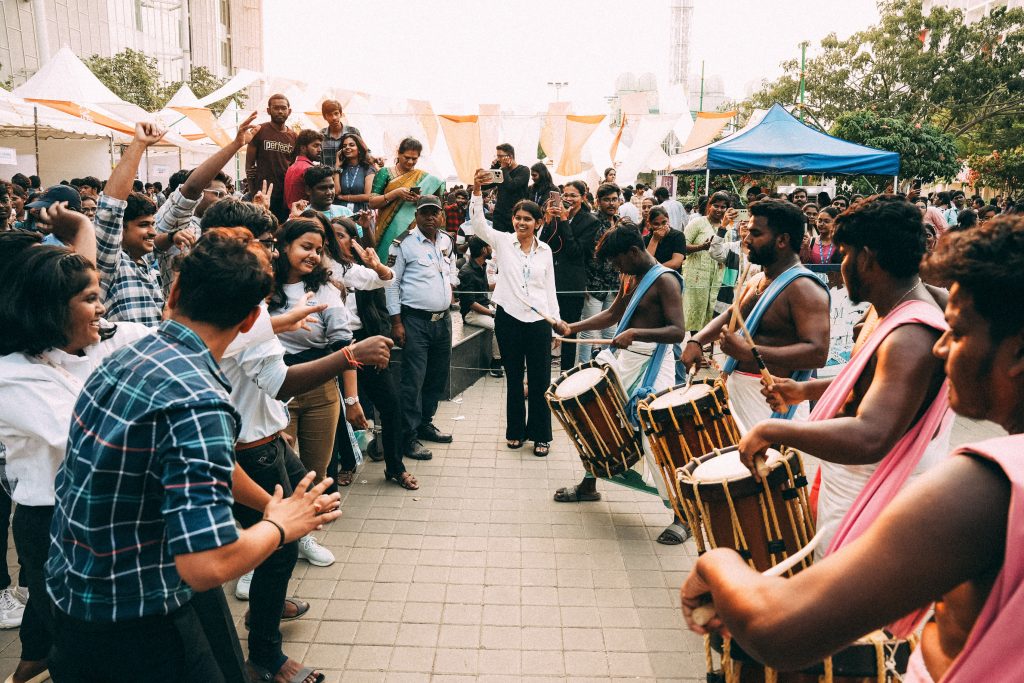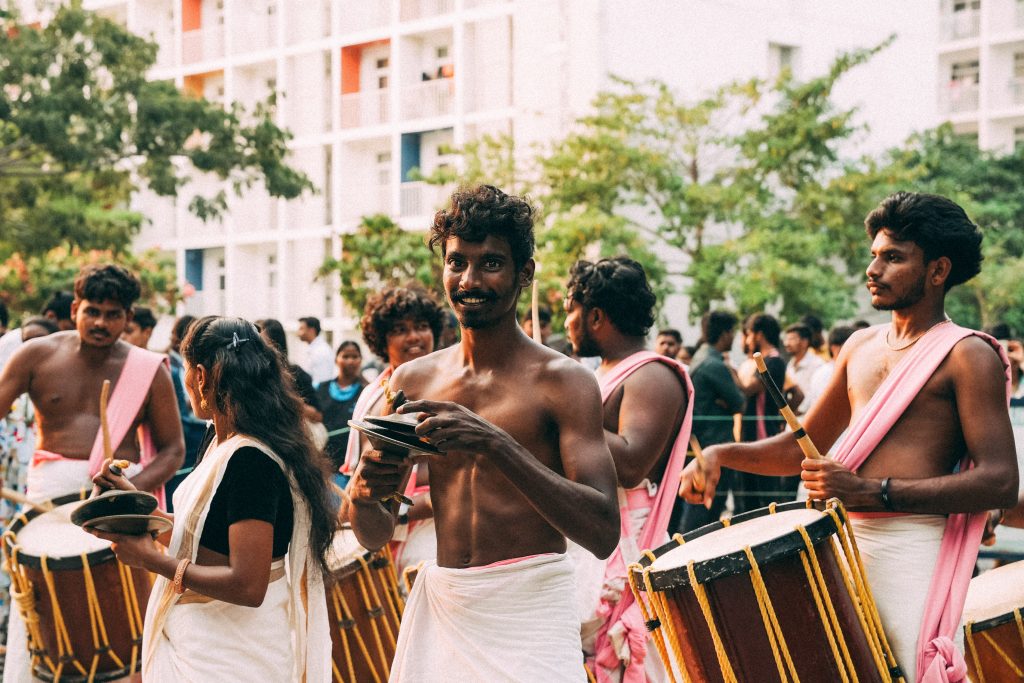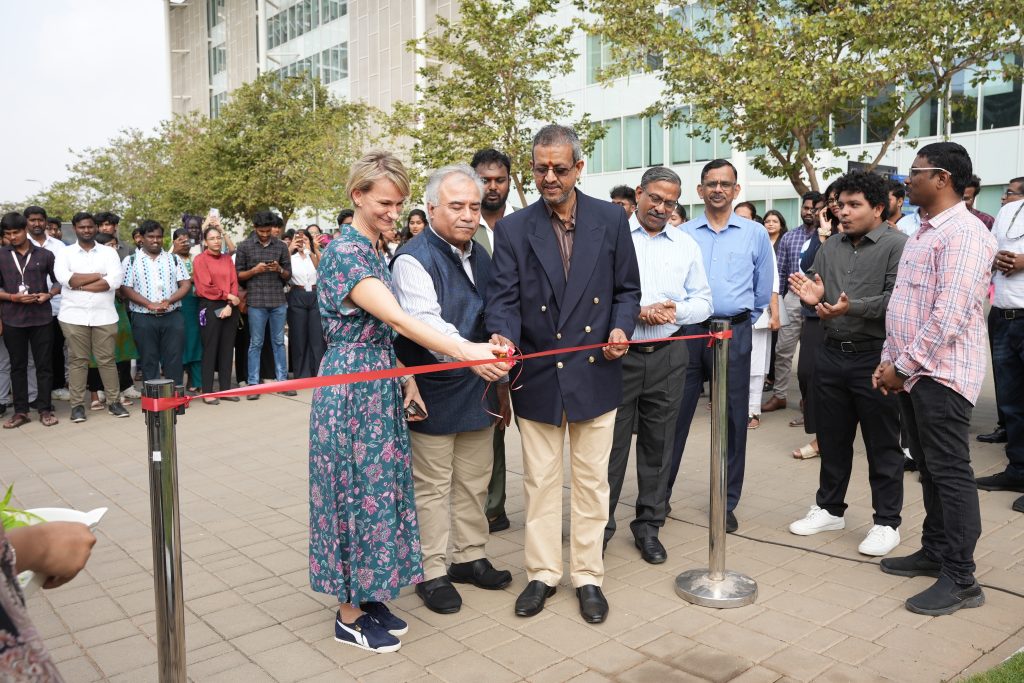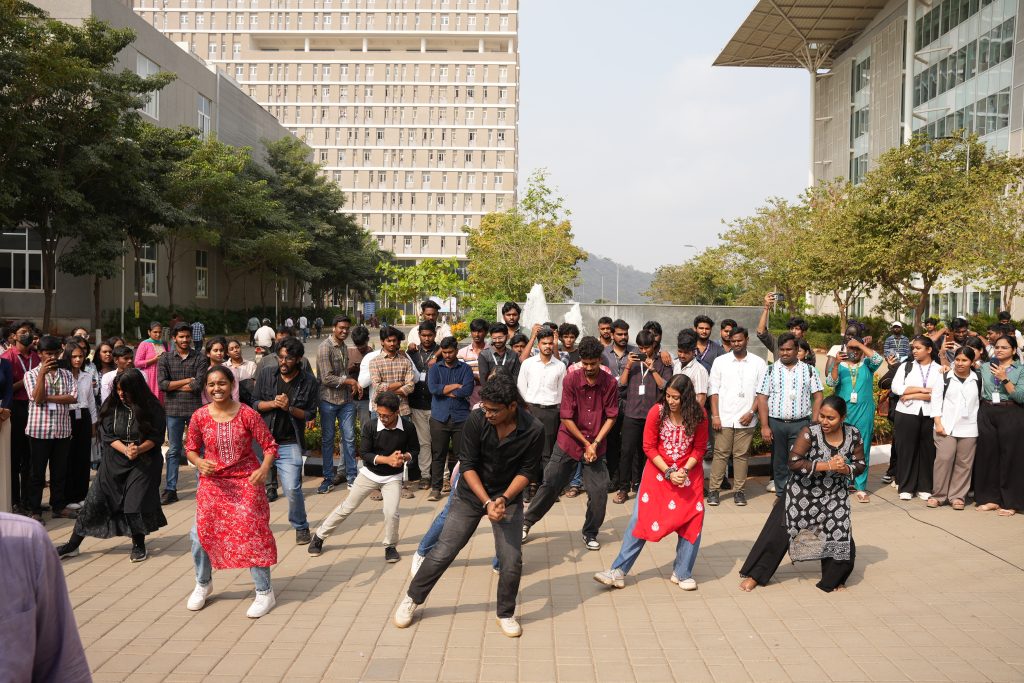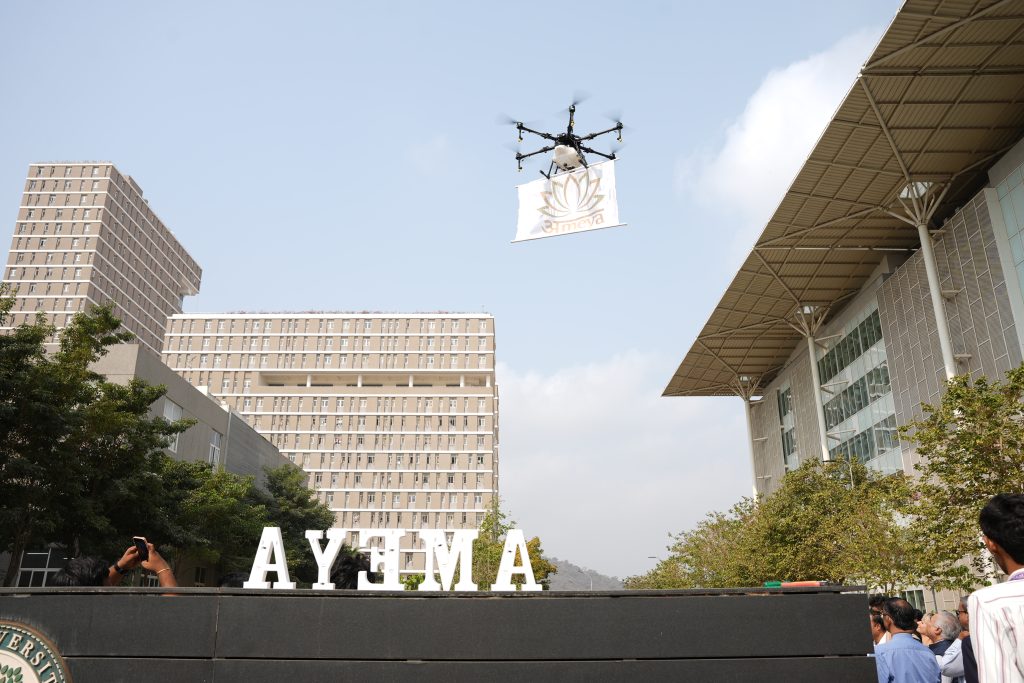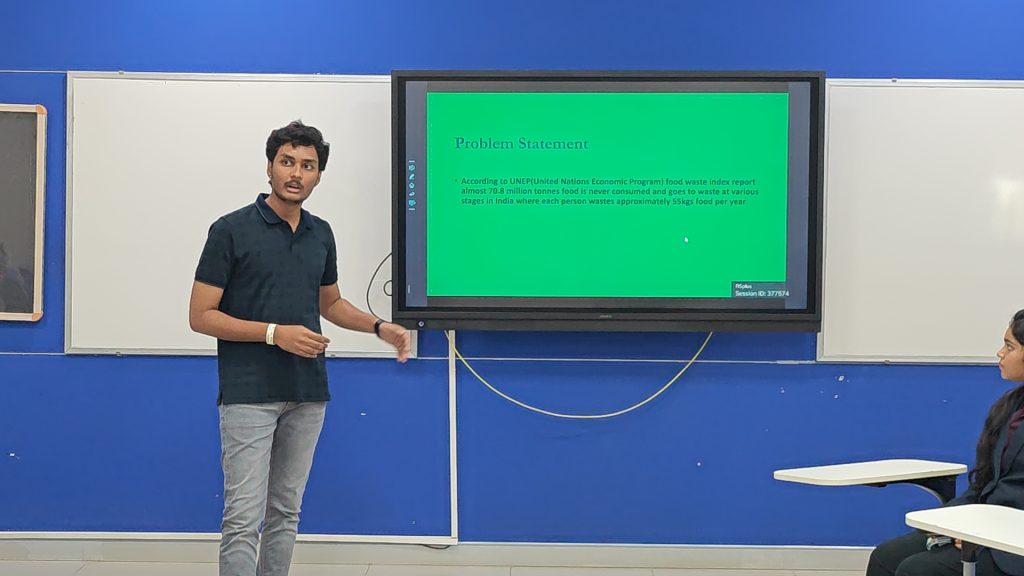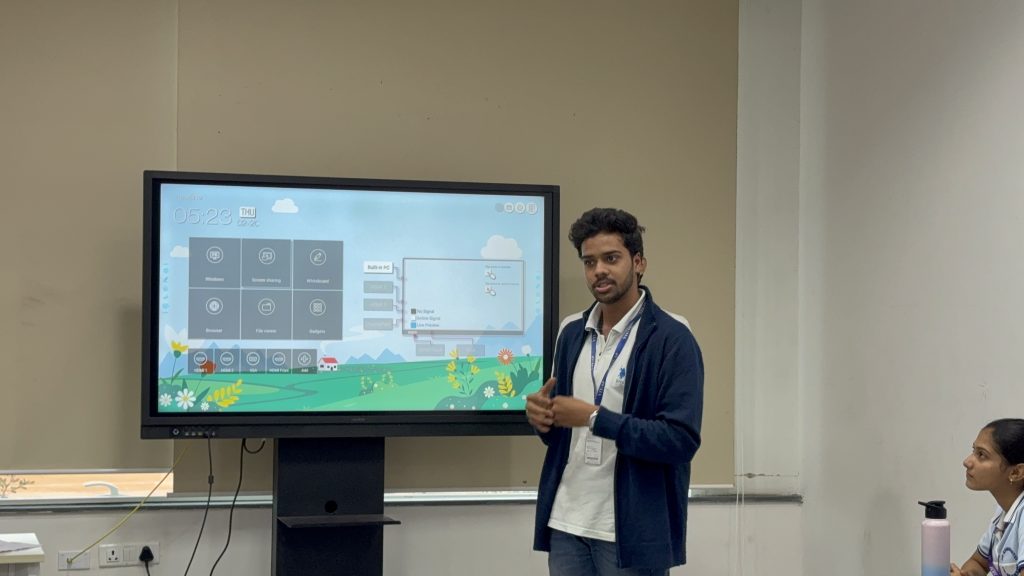Padma Shri P T Usha Inaugurates SRM AP Sports Fest – UDGAM’25
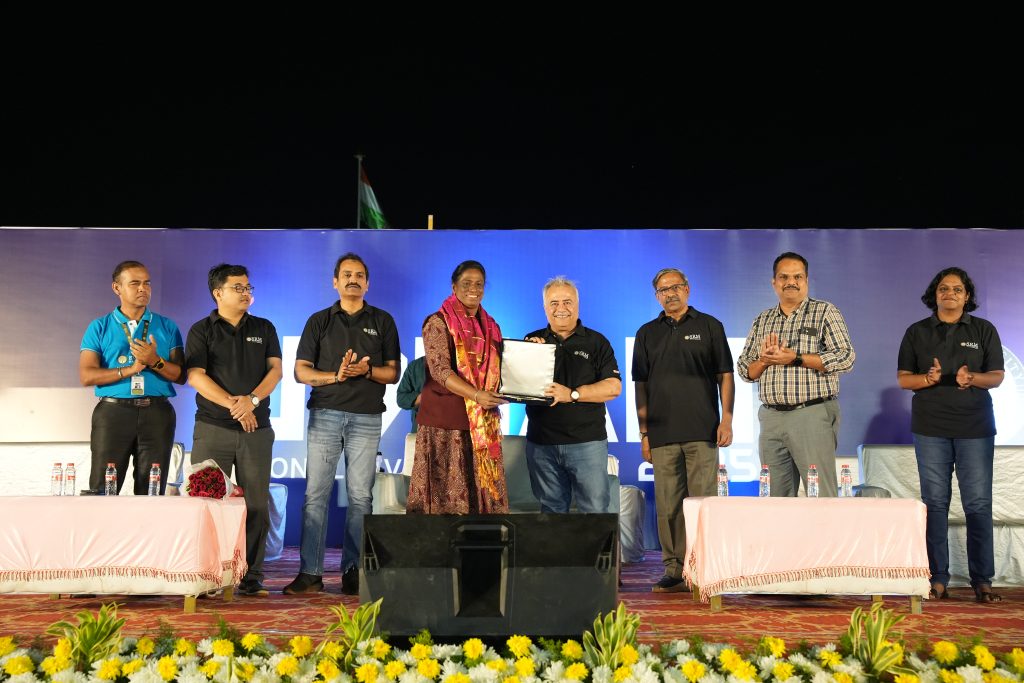 UDGAM ‘25, the National Level Sports Fest was flagged-off in the presence of former Olympian and President of Indian Olympic Association, Padma Shri P T Usha. The National level Meet commenced with the lighting of the Olympic torch marking the start of the 3-day fest. The National Level Sports Fest also transformed into a platform that honoured and celebrated the achievements of sporting legends like Jessie Raj, Retd army officer Mr Varra Prasad Reddy and Ms Akula Hyama.
UDGAM ‘25, the National Level Sports Fest was flagged-off in the presence of former Olympian and President of Indian Olympic Association, Padma Shri P T Usha. The National level Meet commenced with the lighting of the Olympic torch marking the start of the 3-day fest. The National Level Sports Fest also transformed into a platform that honoured and celebrated the achievements of sporting legends like Jessie Raj, Retd army officer Mr Varra Prasad Reddy and Ms Akula Hyama.
UDGAM 2025 is set to witness 40+ competitons with 2000+ students and a promising prize pool of over rupees 10 Lakhs. The meet saw the presence of Registrar Dr R Premkumar; Director I/C Sports and Director-Campus Life Management, Mr Anup Singh Suryavanshi; Assistant Director-Sports, Dr Sushmita Kumari; Faculty, Staff and Students.
Addressing the gathering, Smt P T Usha emphasised the significance of a national level sports fest of this stature. She stated, “Sports have a profound role in shaping character. It is a journey of discipline, persistence and resilience and instills the spirit of never giving up in the face of adversity.”
Vice Chancellor Prof. Manoj K Arora remarked, “UDGAM is our signature sports fest. Our aim is to nurture athletes who will emerge as future champions with our remarkable amenities and infrastructure.” He also wished all the participants to engage wholeheartedly and embody the true spirit of sportsmanship.
The 3-day sports fest aims to bring together athletes from across the country and saw a wide participation from some of the renowned colleges like VIT-AP; Amrita Vishwa Vidyapeetham, Amaravati; Vignan University; K L University; Mohan Babu University, Tirupati; Lakireddy Bali Reddy College of Engineering (LBRCE); Seshadri Rao Gudlavalleru Engineering College, Gudlavalleru, among many others.
The fest will feature individual events, team sports and e-sports along with various track and field events for both men and women. Assistant Director-Sports Dr Sushmita Kumari commented, “UDGAM, our Annual Sports Fest is a forum that does not just test your skills but helps you embody the qualities that define great individuals. In the spirit of sportsmanship, I urge all participants to compete with integrity and passion and inspire us all with your performances”
UDGAM 2025 promises to be an exciting avenue for students to showcase their skills and compete at a national level, demonstrating their sporting spirit and talent. Participants will have the opportunity to not just compete against some of the best teams in the country and learn from top coaches but also win lucrative prizes.
- Published in Departmental News, News, Sports News
Patent on Pneumonia Diagnosis Using Deep Learning Techniques
 In the patent titled “A System and a Method For Real-Time Pneumonia Diagnosis On a Resource- Constrained Hardware Platform,” authored by Prof. Siva Sankar Yellampalli from the Department of ECE and his research scholars – Mr Rahul Gowtham Poola and P L Lahari, a novel diagnostic solution is presented to enhance pneumonia detection in low-resource settings. With Application No: 202441084727, this research explores the integration of advanced deep learning techniques with a compact microcontroller-based system, providing an innovative approach to improve healthcare accessibility and prompt medical intervention.
In the patent titled “A System and a Method For Real-Time Pneumonia Diagnosis On a Resource- Constrained Hardware Platform,” authored by Prof. Siva Sankar Yellampalli from the Department of ECE and his research scholars – Mr Rahul Gowtham Poola and P L Lahari, a novel diagnostic solution is presented to enhance pneumonia detection in low-resource settings. With Application No: 202441084727, this research explores the integration of advanced deep learning techniques with a compact microcontroller-based system, providing an innovative approach to improve healthcare accessibility and prompt medical intervention.
Abstract:
The research focuses on the development of an innovative system for real-time pneumonia diagnosis leveraging advanced deep learning techniques integrated with edge computing technology. The proposed solution employs the MAX78000 microcontroller, a resource-constrained hardware platform, to deploy a sophisticated neural network model capable of analyzing chest X-ray images. The invention addresses the pressing need for accessible, cost-effective, and efficient diagnostic tools in under-resourced and remote environments. The system encompasses a complete diagnostic pipeline, including image acquisition via an onboard parallel camera module, real-time image processing, and display of results on a 3.5″ touch-enabled TFT screen. The deep learning model, optimized for the constraints of the MAX78000, performs real-time classification of chest X-ray images into either normal or pneumonia-affected categories. By operating entirely on-device, the system eliminates the need for high-power servers or internet connectivity, thereby reducing latency and dependency on external infrastructure. This research emphasizes portability, energy efficiency, and low-cost deployment, making the solution highly suitable for primary healthcare facilities, rural clinics, mobile health units, and disaster-response scenarios. With the ability to deliver immediate, accurate diagnoses, the device significantly enhances clinical decision-making and enables timely medical intervention. Additionally, the scalable and adaptable design of the system opens possibilities for broader medical imaging applications, extending its utility beyond pneumonia diagnostics. Experimental results showcase the performance of the neural network model, demonstrating prediction accuracies ranging between 66% and 97% for different test cases on the MAX78000 microcontroller. These findings underline the potential of the proposed system as a transformative tool for advancing point-of-care diagnostics in low-resource settings.
Explanation in Layperson’s terms.
The research presents a compact, affordable device that helps doctors quickly detect pneumonia by analyzing chest X-ray images in real-time. It uses advanced artificial intelligence (AI) technology, called deep learning, to examine the X-rays and determine whether a patient has pneumonia or not. What makes this device special is that it works entirely on a small, low-power microcontroller called the MAX78000, instead of needing powerful computers or internet access. The process begins when the device captures a chest X-ray image using its built-in camera. Then, the AI model, which has been trained to recognize patterns associated with pneumonia, analyzes the image. The results are displayed instantly on a small screen, allowing healthcare providers to make quick decisions. This real-time diagnosis can be life-saving, especially in emergency or rural settings where access to advanced medical equipment or high-speed internet is limited. Technically, this system combines AI and edge computing, meaning all the heavy processing happens directly on the device rather than in remote servers. This design keeps costs low, ensures patient data privacy, and makes the device highly portable and energy-efficient. The technology can work even in places with unreliable electricity, making it ideal for use in mobile health units, rural clinics, or disaster zones. Additionally, the invention can be adapted for diagnosing other diseases, showcasing its versatility in improving healthcare globally.
Practical Implementation
This research can be practically implemented as a compact, standalone device for diagnosing pneumonia in healthcare settings where access to advanced medical equipment is limited. It works as follows:
- Deployment in Rural Clinics and Mobile Health Units: The device can be used in clinics in remote or underserved areas where large X-ray machines and advanced computing resources are unavailable. It provides on-the-spot diagnosis.
- Point-of-Care Diagnostics: The portability and integration of image acquisition, AI-based processing, and display into a single unit make it ideal for bedside use in hospitals or during emergency care.
- Disaster Response: Its low-power and internet-free design make it a critical tool in disaster zones, refugee camps, or any setting where power and connectivity are unreliable.
- Telemedicine Integration: The device can complement telemedicine by providing accurate diagnostic results to remote doctors, helping bridge the gap between frontline healthcare workers and specialists.
Social Implications
Improved Access to Healthcare: By making pneumonia diagnosis accessible in rural and underserved regions, this device can drastically reduce the gap in healthcare services between urban and remote areas. It empowers healthcare providers in low-resource settings to deliver timely diagnoses.
- Affordability: The use of a low-cost microcontroller ensures that the device is affordable for governments and healthcare organizations, particularly in developing countries. This can enhance healthcare access for low-income populations.
- Reduced Mortality Rates: Pneumonia is a leading cause of death in children under five and elderly individuals, especially in low-income countries. This device’s ability to provide real-time, accurate diagnosis allows for earlier intervention and treatment, potentially saving countless lives.
- Privacy and Security: Since all data is processed locally on the device, it ensures patient privacy by eliminating the need to transfer sensitive medical data to cloud servers, addressing concerns about data security.
- Scalability: The underlying technology can be adapted to diagnose other diseases, creating a broader impact on global health. For example, similar systems could be used for tuberculosis, COVID-19, or other respiratory conditions, further enhancing healthcare infrastructure.
By addressing critical gaps in diagnostic capabilities and ensuring accessibility and affordability, this research has the potential to transform healthcare delivery and improve quality of life, especially in marginalized communities.
Collaborations:
Rahul Gowtham Poola, Ph.D Scholar, Dept of ECE, SRM University-AP
P.L. Lahari, Ph.D Scholar, Dept of ECE, SRM University-AP
Prof. Siva Sankar Yellampalli, Professor of Practice, Dept of ECE, SRM University-AP
- Published in Departmental News, ECE NEWS, News, Research News
Dr Haque’s Patent Revolutionises the Digital Marketing Landscape
 The patent titled “System and Method for Controlling the Dissemination of Data on Digital Platforms,” authored by Assistant Professor, Dr M Asadul Haque from the Department of Management and his research Scholar Mr Suman Kumar Tiwari offers an innovative approach to enhancing advertising strategies on digital platforms. With application number 202541004114, their patent outlines a comprehensive system that utilises real-time data collection and analysis to optimise consumer engagement and improve brand effectiveness in the ever-evolving landscape of social media advertising.
The patent titled “System and Method for Controlling the Dissemination of Data on Digital Platforms,” authored by Assistant Professor, Dr M Asadul Haque from the Department of Management and his research Scholar Mr Suman Kumar Tiwari offers an innovative approach to enhancing advertising strategies on digital platforms. With application number 202541004114, their patent outlines a comprehensive system that utilises real-time data collection and analysis to optimise consumer engagement and improve brand effectiveness in the ever-evolving landscape of social media advertising.
Abstract
The patent outlines a novel system and method for optimizing the dissemination of data on digital platforms, specifically targeting the enhancement of advertising strategies through real time data collection and analysis. This system leverages APIs and web scraping for continuous, up-to-date consumer behaviour monitoring, enabling brands to make immediate adjustments to their advertising tactics based on current trends and insights. It employs advanced machine learning algorithms and sentiment analysis to detect intricate consumer response patterns, offering a nuanced understanding of advertisement effectiveness. Additionally, the system supports dynamic strategy optimization, facilitating real-time adjustments to advertising efforts in response to market and consumer behaviour shifts. It incorporates a holistic evaluation approach, considering various mediating and moderating factors such as consumer attitudes and platform types. Designed for scalability across multiple social media platforms, the system ensures compliance with data privacy regulations while performing real-time data collection and analysis. Ultimately, this patent presents a comprehensive feedback system aimed at improving consumer engagement and conversion rates through personalized and effective advertising strategies.
Explanation in Layperson’s terms
The research presents an innovative system aimed at improving advertising strategies on social media platforms. This smart system uses data analysis and machine learning to help brands understand the impact of their ads on consumer buying decisions. By collecting and analysing data from social media, it considers various factors such as ad content, social trends, and consumer sentiments. The system can predict the effectiveness of different advertising strategies before they are implemented, enabling brands to make informed decisions.
Traditional methods focus on basic metrics like ad clicks, but this invention provides a comprehensive view of what influences consumer behavior. It allows brands to adjust their advertising strategies in real-time based on consumer reactions, making campaigns more effective.
Benefits for businesses include better consumer engagement, higher sales, data-driven decision-making, and more efficient use of advertising budgets. The technology is particularly valuable for marketing agencies, online retailers, consumer product companies, and tech startups focused on marketing solutions.
Practical Implementation
The practical implementation of the new advertising system involves several key steps to ensure its effectiveness and ethical use. Firstly, the system integrates with existing social media platforms and advertising tools like Facebook Ads and Google Ads, enhancing advertising strategies. To ensure successful adoption, companies need to provide comprehensive training and support for their marketing teams, enabling them to use the new tools and interpret insights effectively. Before a full-scale rollout, businesses can conduct pilot programs to test the system on a smaller scale and make necessary adjustments based on real-world results. Ensuring adherence to data privacy regulations, such as GDPR, is crucial for the responsible and ethical handling of consumer data. Additionally, the system can be customized to meet the specific needs of various industries, by analysing sector-specific consumer behaviour and trends, which ensures tailored and effective advertising strategies.
Social Implications
The social implications of implementing the new advertising system are multifaceted. Firstly, it enhances consumer awareness by enabling brands to create more relevant and personalized advertisements, thus improving consumer experience and engagement. However, there is a potential risk of market saturation, where the overuse of similar strategies by multiple brands could overwhelm consumers with excessive ads. Privacy concerns are also significant, as increased data collection necessitates a careful balance between effective targeting and respecting consumer privacy. Additionally, automation and advanced analytics may shift job roles within marketing teams, prompting the need for reskilling towards more strategic, creative, and analytical tasks. The system promotes ethical marketing practices by leveraging data-driven insights to prevent misleading advertisements and ensure truthful marketing messages. Lastly, by understanding consumer sentiment, brands can influence societal trends and public perceptions, particularly through socially responsible marketing efforts.
Future Research Plans
• Exploration of Data Privacy Solutions- Investigate methods to enhance data privacy and security while still leveraging consumer data for effective advertising.
• Longitudinal Studies on Consumer Behaviour- Conduct longitudinal studies to understand how consumer behaviour changes over time in response to targeted advertising.
- Published in Departmental News, News, Paari Current Happenings, Research News
Collaboration with Sibar to Boost Research Advancements
 SRM University-AP formalised a significant Memorandum of Understanding (MoU) with the Sibar Institute of Dental Sciences, Guntur. The MoU is aimed at advancing the field of Biomedical Engineering & Biomedical Sciences and leverage SRM University-AP’s technical expertise alongside the medical proficiency of Sibar Institute, to foster groundbreaking innovations.
SRM University-AP formalised a significant Memorandum of Understanding (MoU) with the Sibar Institute of Dental Sciences, Guntur. The MoU is aimed at advancing the field of Biomedical Engineering & Biomedical Sciences and leverage SRM University-AP’s technical expertise alongside the medical proficiency of Sibar Institute, to foster groundbreaking innovations.
The MoU was signed in a ceremony by Principal, Dr B Venkat Ramana Reddy from Sibar Institute of Dental Sciences and Registrar, Dr R Premkumar from SRM University-AP. Notable attendees included Vice Chancellor, Prof. Manoj K Arora, Dean-SEAS Prof. C V Tomy; Dean-Research Prof. Ranjit Thapa; Head of the Department of ECE, Dr K A Sunitha; Chief Medical Officer, Dr Raju Dudam from the SRM AP Medical Centre, alongside faculty from the Departments of Computer Science and Engineering, Electronics and Communication Engineering, Biological Sciences and Chemistry and medical practitioners from Sibar Institute of Dental Sciences including Dean, Dr L Krishna Prasad; Dr K Kiran Kumar, Prof and Head, Department of Oral Pathology; Dr P Chandrashekhar, Professor- Department of Pathology and Dr D Ravinath Professor & Head, Department of Peridontics.
During the event, Vice Chancellor Prof. Manoj K. Arora pointed out the university’s rapid growth in both research and academic realms. He highlighted SRM AP‘s collaborations with esteemed institutions abroad stressing on the varsity’s commitment to interdisciplinary learning and research. Prof. Arora stated, “By merging engineering brilliance with medical sciences, we aim to achieve breakthroughs that will significantly benefit the society.”
Registrar Dr R Premkumar articulated the university’s dedication to research and its mission to bring transformational change. He remarked, “Our Faculty is our greatest asset, and we are prepared to extend all support to foster a transformative change in the society.”
Discussions from Dean-Research Prof. Ranjit Thapa, Dean-SEAS Prof. C V Tomy, and Associate Dean ( Admission Outreach and Research Collaborations), Prof. Jayaseelan Murugaiyan, on the collaborative research opportunities and clinical studies between the two institutions added significant value to the partnership.
Dean, Dr L Krishna Prasad from Sibar Institute of Dental Sciences expressed his enthusiasm in partnering with SRM AP and looked forward to this collaborative engagement to make significant breakthrough in the field of medical sciences and research.
Dr K A Sunitha highlighted the potential for knowledge exchange through this partnership, noting plans for joint data collection and analysis. The collaboration will extend to community welfare too, wherein dental health camps in the six villages adopted by SRM AP will be offered.
- Published in Departmental News, ECE NEWS, News
Ameya’25: The Management Mavericks’ Meet
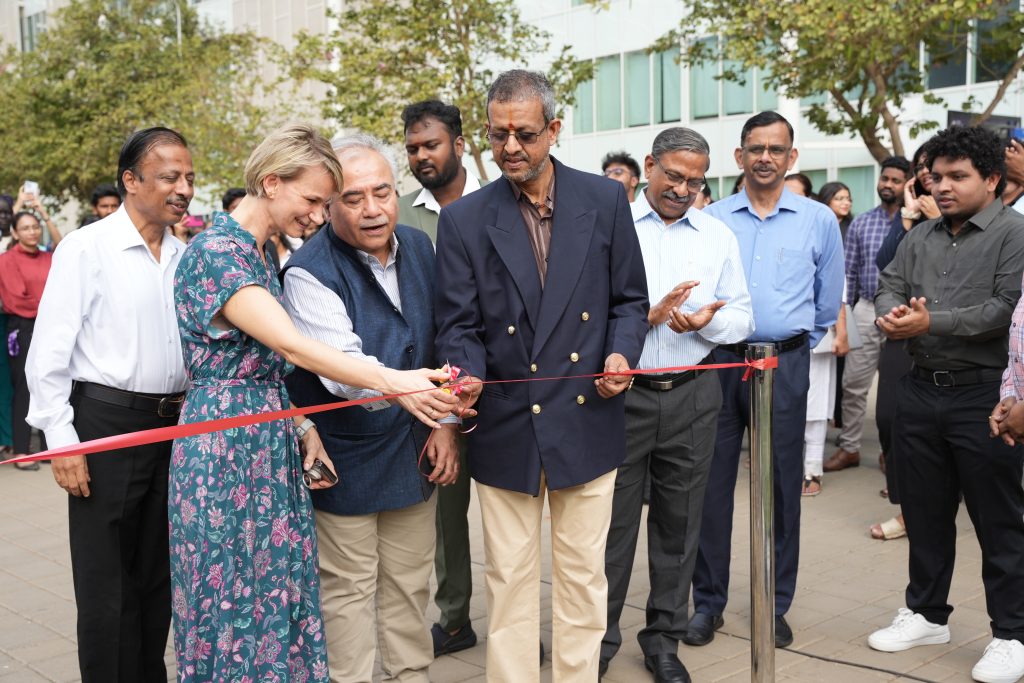 AMEYA 2025, the annual flagship event of SRM University-AP’s management precinct, concluded with great success. The two-day event brought together a vibrant mix of entrepreneurial spirit, formal business interactions, and engaging cultural activities, creating an amalgamation of spirit, strategy and synergy. With Business Standard as its media partner and Board Infinity, IDP International Education Specialist, Unstop, Simple, and Dream Abroad as its other collaborative partners, AMEYA 2025 provided a platform for innovative ideas and networking opportunities.
AMEYA 2025, the annual flagship event of SRM University-AP’s management precinct, concluded with great success. The two-day event brought together a vibrant mix of entrepreneurial spirit, formal business interactions, and engaging cultural activities, creating an amalgamation of spirit, strategy and synergy. With Business Standard as its media partner and Board Infinity, IDP International Education Specialist, Unstop, Simple, and Dream Abroad as its other collaborative partners, AMEYA 2025 provided a platform for innovative ideas and networking opportunities.
The B-Fest was officially launched by Vice-Chancellor Prof. Manoj K Arora, Registrar Prof. R Prem Kumar, and Dean-Paari School of Business, Prof. Bharadhwaj Sivakumaran The highlight of the inauguration was the unveiling of the AMEYA flag through a drone, symbolising the limitless potential the fest aimed to unlock. The event also attracted more than 600 external participants from various educational institutions such as VIT University, Amrita Vishwa Vidyapeetham, Andhra Loyola College, Nalanda Degree College, Loyola Public School, Vignan, KL University and Siddhartha College among many others.
Some of the highlights of AMEYA ’25 were Business Quiz – The Auctor Inquirer, which challenged participants’ knowledge of business concepts and current affairs. The highlight of the formal events was Magistrus – The Skill Manager, a Best Manager event that assessed participants’ leadership, decision-making, and multitasking abilities. Among the many informal events were the IPL Auction, Reel, Open Mic / Stand-Up Comedy, Biz Hunt, the Mr & Ms Ameya competition and lastly the awe-inspiring Chenda Melam.
With 28 winners emerging victorious across a range of competitions, the event showcased exceptional talent. Mr Dishi Jain and Ms Octavio \were crowned Mr & Ms AMEYA’25; Mr Vignesh and his team triumphed in the Biz Hunt alongside Shashank and his team as the runner ups. Shaleem Raju, John Hamsa and Kannam Naidu won the B-Quiz. The fest proved that success knows no bounds when passion and talent unite. AMEYA’25 truly lived up to its name: boundless in spirit, competition, and celebration.
- Published in Departmental News, News, Paari Current Happenings
Patent on CBVR Published by Dr Jatindra Dash
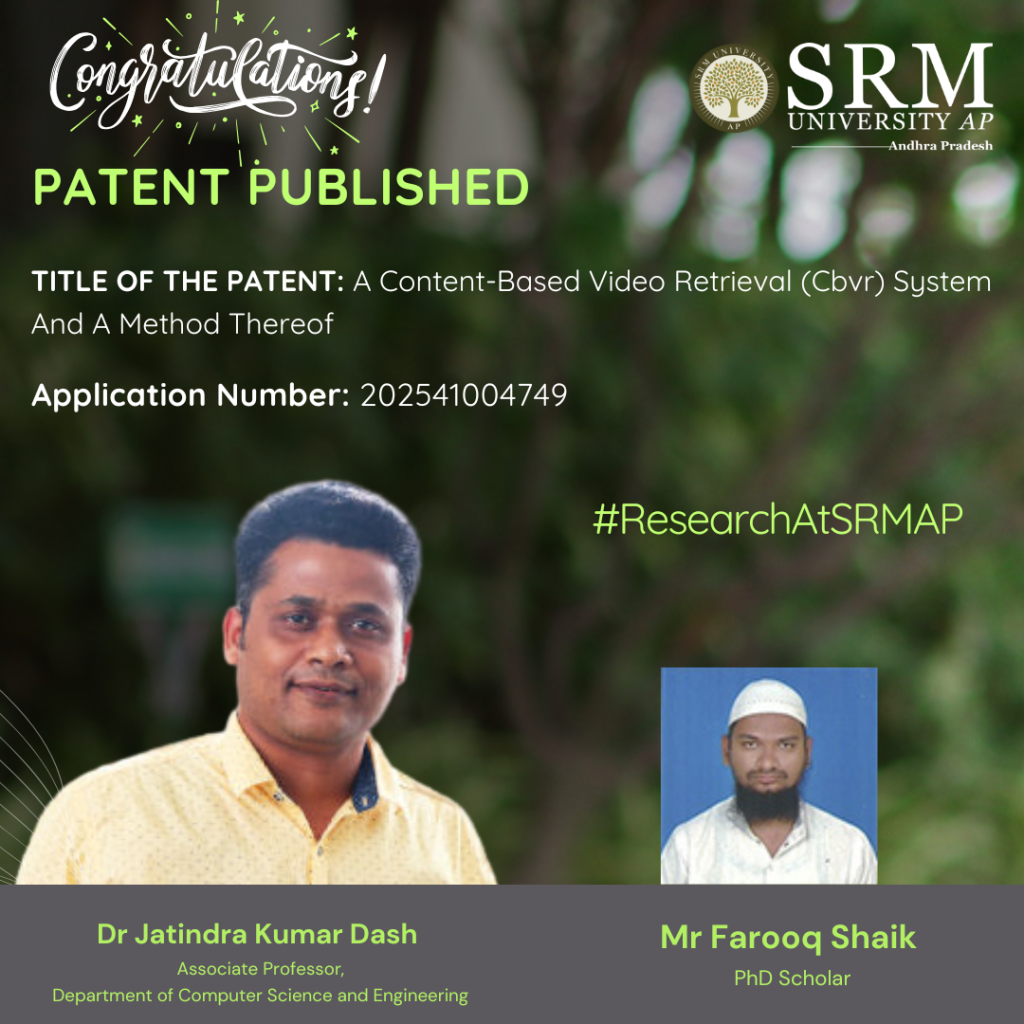 The Department of Computer Science and Engineering is delighted to announce the publication of a patent titled “A Content-Based Video Retrieval (CBVR) System and Method Thereof,” with application number 202541004749. The invention offers an efficient and accurate approach developed for content-based video retrieval by Dr Jatindra Kumar Dash, Associate Professor in the Department, along with his PhD scholar, Mr Farooq Shaik.
The Department of Computer Science and Engineering is delighted to announce the publication of a patent titled “A Content-Based Video Retrieval (CBVR) System and Method Thereof,” with application number 202541004749. The invention offers an efficient and accurate approach developed for content-based video retrieval by Dr Jatindra Kumar Dash, Associate Professor in the Department, along with his PhD scholar, Mr Farooq Shaik.
Brief Abstract:
Imagine searching for a specific scene in a movie, not by remembering its title or actors, but by describing the action itself. This is the essence of content-based video retrieval (CBVR), a technique that searches for a video based on what’s inside it, rather than relying solely on manually assigned labels. Unlike traditional methods, which can be time-consuming, error-prone, and struggle with vast datasets, CBVR offers a more efficient and accurate approach. Our proposed system leverages the strong capability of deep learning, a subset of artificial intelligence, to analyse videos and extract their key characteristics. This process occurs in two stages: offline and online. Through the first stage, important features are extracted from all videos in the dataset and stored for future use. When a user submits a query video, its features are extracted in real-time (online) and compared to the stored features of all videos. The videos with features most similar to the query, essentially those with the “closest match” are then presented to the user. To capture the full essence of a video, our system employs a two-stream neural network architecture. This innovative approach allows us to extract both temporal features, which capture the changes and motion patterns within the video (think: someone running or jumping), and spatial features, which pivot about the static visual content of each individual frame (think: the objects and scene depicted).By utilizing a pre-trained neural network called ResNet-60, our system benefits from existing knowledge and can efficiently extract meaningful features from videos. To evaluate its effectiveness, we tested our system on the UCF101 dataset, a widely used benchmark consisting of 101 categorized videos. Our approach obtained accuracy 93,7\% for top 5 retrieval and 95.95\% for top 10 retrieval. The outcomes illustrate that our approach obtains superior accuracy compared to other state-of-the-art video retrieval methods.
Explanation in Layperson’s Terms:
Most of video searching platforms relay on meta data attached to video to search and retrieve videos. For example you tube utilize video name description attached to video while uploading. How ever this approach is time consuming, error prone, and need human intervention. Our proposed CBVR system aims to retrieve videos based on content of video similarity rather than meta tags. Proposed article utilized pre trained Deep neural network particularly ResNet-50 a convolutional neural network with residual skip connections to learn video representation by employing LBP representation and Temporal map of the video.
Practical Implementation and Social Implications
The research focus on CBVR a technique that enables users to search videos based on content rather than meta tags. It has many practical implementations in various industries, such as Surveillance and security (like to search large surveillance feed particular incident), Health care and medical imagining(where doctor retrieve similar medical video for faster diagnosis), Education , Entertainment.
The research has significant social implications such as Improved accessibility to information, enhanced public safety, Advancing ai in daily lifes. Using this system in smart cities and digital systems.
Collaborations
Experiments are conducted on publicly available Dataset on DGX-1 server available at our university premises. In future we may plan to collaborate with local authorities for real time video feed to enhance proposed method capabilities.
Future Research Plans
Further in to research our plan is to propose a robust system that can be scaled and applied to all scenarios of videos may it be Medical videos, Education. Further proposed method is supervised approach, we want to explore unsupervised methods to generalize video retrieval.
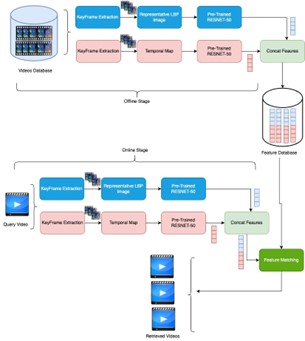
- Published in Departmental News, News, Research News
Dr Debajyoti’s Research on Improving Biofuel Production
 In the quest for sustainable energy solutions, Dr Debajyoti Kundu, from the Department of Environmental Science and Engineering, examines the potential of biofuels through his research paper – “Heterogeneous Catalysts for Sustainable Biofuel Production: A Paradigm Shift Towards Renewable Energy.” The paper highlights the importance of heterogeneous catalysts for improving biofuel production efficiency. The research also suggests future research to support sustainable energy practices.
In the quest for sustainable energy solutions, Dr Debajyoti Kundu, from the Department of Environmental Science and Engineering, examines the potential of biofuels through his research paper – “Heterogeneous Catalysts for Sustainable Biofuel Production: A Paradigm Shift Towards Renewable Energy.” The paper highlights the importance of heterogeneous catalysts for improving biofuel production efficiency. The research also suggests future research to support sustainable energy practices.
Brief Abstract:
This study focuses on the use of heterogeneous catalysts for sustainable biofuel production. With the growing concerns around fossil fuel depletion and environmental pollution, biofuels derived from biomass are emerging as promising alternatives. The article explores the significant role of heterogeneous catalysts in enhancing biofuel production by improving conversion efficiency, recyclability, and environmental impact. By analyzing various biomass sources, structural compositions, and the application of catalysts in bioethanol, biobutanol, biodiesel, biogas, and biohydrogen production, the study highlights recent advancements and provides recommendations for future research to drive sustainable energy solutions.
Explanation in layperson’s terms:
This research looks at how we can produce more environmentally friendly fuels from natural materials like plants and waste. Traditional fuels like oil and coal are harmful to the environment, so we are turning to biofuels made from biomass (such as plants) as a cleaner alternative. A key part of making biofuels efficiently is using special catalysts—materials that help speed up chemical reactions. The study examines how different catalysts are used to convert biomass into biofuels such as bioethanol, biodiesel, and biogas. The goal is to improve the processes, making biofuels more sustainable and accessible for the future.
Practical Implementation and Social Implications:
This research has significant implications for advancing renewable energy. The use of heterogeneous catalysts can make biofuel production more efficient and environmentally friendly, reducing reliance on fossil fuels and mitigating climate change. By optimizing biofuel production processes, we can develop cleaner energy solutions that are sustainable, carbon-neutral, and beneficial for the environment. This study also supports the ongoing shift towards renewable energy, ensuring that biofuels can contribute to reducing global energy crises and health risks associated with fossil fuel use.
Future Research Plans
Our future research will focus on the development and optimization of biocatalysts for the bioconversion of biomass into biofuels. We aim to enhance the efficiency and sustainability of biocatalytic processes, exploring new catalysts and reaction conditions that can improve the conversion of various biomass feedstocks into valuable biofuels. This research will contribute to advancing biofuel production technologies, with an emphasis on reducing environmental impact and improving the scalability of bioconversion processes for renewable energy solutions
- Published in Departmental News, ENVS News, News, Research News
Tech Wizards Claim South Zone Title at Nation Building Competition
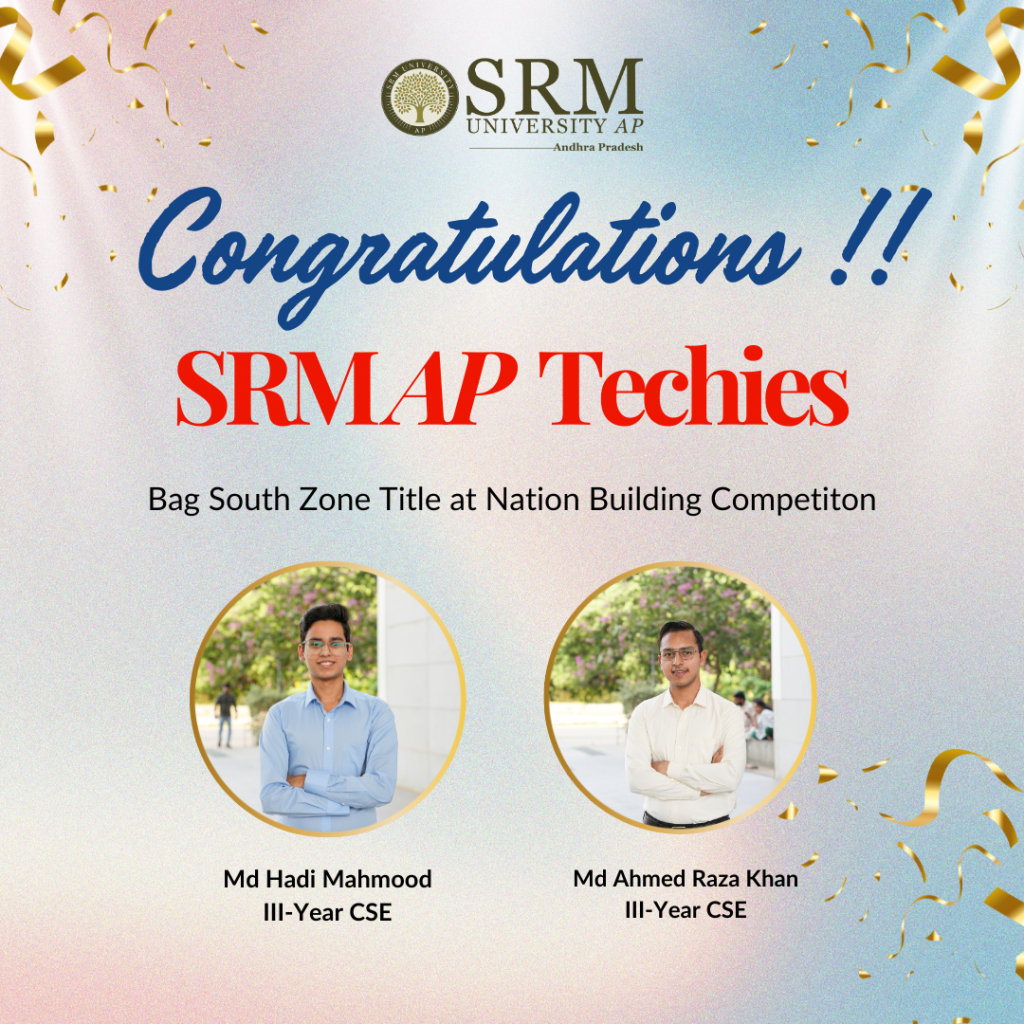
In a world where the potential of GenZs is often questioned, two of our students, Md. Hadi Mahmood and Md Ahmed Raza Khan have proven that their engagement can deliver meaningful change. These III-year BTech CSE students have showcased an inspiring display of their intellect and innovative prowess at the Nation Building Case Study Competition, an annual event that aligns with the “Viksit Bharat” initiative led by Hon’ble Prime Minister Shri. Narendra Modi, inviting college teams from across the nation to develop creative strategies aimed at transforming India into a developed country by 20247.
Here’s an excerpt of their interview:
1. What was the competition/event about?
The NationBuilding Case Study Competition is an annual event organised to inspire young college students to contribute to India’s development by addressing critical national issues. Participants engage in a 2-month-long journey involving multiple rounds, including an online quiz, presentation submissions, zonal finals, and the national finals in New Delhi. The competition is judged by a distinguished panel of experts in the given domain.
This year’s competition, NationBuilding Case Study Competition 2025, focused on the problem statement of identifying the gaps in India’s sports environment. Participants were tasked with studying the sports systems of other countries, analysing their strengths, and drafting a model to achieve India’s vision of hosting and winning 100 medals in the Olympics by 2036. This theme aimed to encourage innovative solutions to elevate India’s standing in global sports and align with the broader goal of nation-building.
2. What place did you secure?
We secured the 1st rank in the South Zone during the third round of the competition, competing against teams from multiple prestigious institutions. This achievement has advanced us to the national finals, where we will compete against the top 2 teams from each of the six zones: North, South, East, North East, West, and Central.
3. How did you find out about the competition?
We discovered this opportunity on the Unstop platform. The NationBuilding Case Study Competition is widely recognised and attracts thousands of teams annually, making it a highly sought-after event for students across India.
4. Who were your competitors
In the South Zone, we competed against 10 teams from premier institutions. The competition was intense, as participants brought innovative solutions to the table, reflecting the high level of talent and dedication among the youth.
5. Your feelings on advancing this far and future aspirations.
We are excited to have advanced to the national finals. Competing against the best teams from across the country is both a challenge and an opportunity to showcase our strategic thinking and problem-solving skills. This competition has allowed us to apply our skills & knowledge to real-world issues, which has been incredibly rewarding. We look forward to the final round and hope to contribute meaningfully to the vision of a developed India.
- Published in CSE NEWS, Departmental News, News, Students Achievements
MoU with SHRI Opens New Pathways in Medicine
In an effort towards enhancing academic and research capabilities, SRM University-AP and Samishta Hospital and Research Institute (SHRI) formalised an understanding on scientific cooperation in biological sciences and other areas of mutual interest. The MoU signing ceremony that took place at SRM University-AP and was signed by Dr R Premkumar, Registrar- SRM University-AP and Dr Kalyan Chakravarthy, Managing Director-Samistha Hospital and Research Institute, Guntur in the presence of Dr Sandeep and Dr Ravi Teja, Dr Varun, Dr Ramakrishna, Dr Gnana Prakash Doctors from SHRI and Prof. C V Tomy, Dean-School of Engineering and Sciences; Prof. Ranjit Thapa, Dean-Research; Prof. Jayaseelan Murugaiyan, Associate Dean-Sciences (Admission Outreach and Research Collaborations); Assistant Professors at the Department of Biological Sciences-Dr Sutharsan Govindarajan, Dr Anil K Suresh, Dr Prateek Gupta among others.
The MoU will open pathways for collaborative opportunities in research and academics, fostering joint research projects and funding possibilities while also emphasising the importance of skill development through seminars organised by both the institutions.
Registrar Dr R Premkumar highlighted the significance of this partnership and the potential outcomes of the joint venture. Dr Sutharsan Govindarajan thanked the team from Samistha Hospitals and Research Centre for joining hands and taking the phase therapy from bench to bedside. This MoU between the two institutes of eminence aims to create a dynamic environment for innovative research that will benefit not just our institutions but also the society in general.
- Published in Biology News, Departmental News, MoU, News
Dr Kaur Explores New Frontiers in Mathematics
 Dr Surinder Kaur, Assistant Professor at the Department of Mathematics is making significant contributions to the mathematical community and SRMAP’s research wing, her research on understanding the group rings and addressing challenges such as the isomorphism problem for group algebra through her project has earned her a funding of ₹ 4.28 lakh from the prestigious National Board for Higher Mathematics (NBHM). Dr Kaur’s impressive research work has become a source of inspiration to many. Given below are some details on her project titled, “On the group rings, their unit groups and some related questions”
Dr Surinder Kaur, Assistant Professor at the Department of Mathematics is making significant contributions to the mathematical community and SRMAP’s research wing, her research on understanding the group rings and addressing challenges such as the isomorphism problem for group algebra through her project has earned her a funding of ₹ 4.28 lakh from the prestigious National Board for Higher Mathematics (NBHM). Dr Kaur’s impressive research work has become a source of inspiration to many. Given below are some details on her project titled, “On the group rings, their unit groups and some related questions”
A Brief Description of the Project
In this project, we aim at obtaining the structure and generators of the unit group of some group rings with a focus on answering the normal complement problem for them. Our further goal is to solve the celebrated isomorphism problem for group algebras of certain classes of groups, especially the twisted version of this problem for group algebras of nilpotency class at least 3. We also plan to look into certain questions in the representation theory of association schemes that are driven by what happens for group algebras.
Explanation of Research Objectives in layperson’s terms
In the last century, the work of E. Noether, F.G. Frobenius and R. Brauer have established that group rings play a central role in the development of representation theory. Further investigations indicated that these objects also have a great influence on the study of other areas of Mathematics like algebraic number theory, algebraic K-theory and algebraic topology. Moreover, the vital role it has played in the recent development of homological algebra and algebraic coding theory is worth acknowledgement.
- Published in Departmental News, Faculty Achievements, Math News, News


